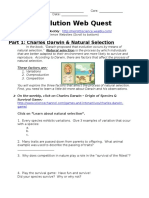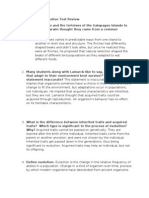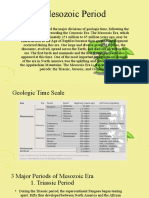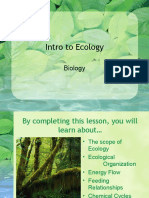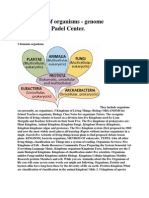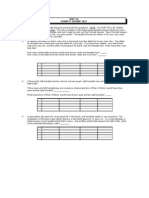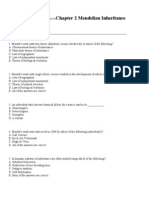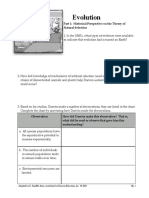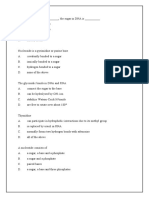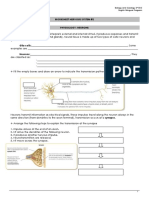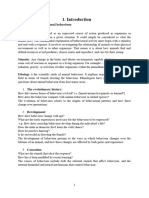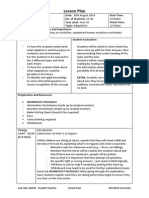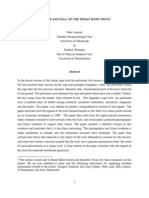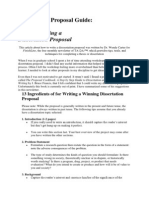Evolution Worksheet - Adaptation
Evolution Worksheet - Adaptation
Uploaded by
api-262728326Copyright:
Available Formats
Evolution Worksheet - Adaptation
Evolution Worksheet - Adaptation
Uploaded by
api-262728326Original Title
Copyright
Available Formats
Share this document
Did you find this document useful?
Is this content inappropriate?
Copyright:
Available Formats
Evolution Worksheet - Adaptation
Evolution Worksheet - Adaptation
Uploaded by
api-262728326Copyright:
Available Formats
EVOLUTION: ADAPTATION
All organisms and species adapt. This includes both plant and animal.
Warnbro Community High School Evolution: Adaptation Information Sheet 2014
What is adaptation?
Adaptation can be explained as an adjustment in the
behaviour, physiology, or structure of an organism where the
change or mutation makes them more suitable to their
environment and improves function. Organisms that possess
heritable traits can adapt better to their surroundings,
compared to other members of their species, and are more
efficient when it comes to survival because of these
favourable traits. Because they are more likely to survive,
there is an increased chance that they will reproduce and pass
on more of
their genes
to the next generation. As more and more
organisms inherit the mutation, it becomes a
more permanent part of the species and becomes an
adaptation. This also forms the basis of natural
selection.
Why do animals adapt?
There are a many number of reasons why animals adapt and make progressive changes as they evolve.
Generally, it is a matter of survival: adapting allows organisms to do a number of things such as blending into
an environment, evading predators, scaring away
predators, catching prey or food easier, socialising
, performing more complex tasks, regulating body
temperature (e.g. staying warm or cool),
finding/maintaining shelter, restoring energy, or
replenishing stamina quickly amongst others.
Adaption is required to avoid extinction.
Types of adaptation:
Behavioural (top right):
Behavioural adaptations are, as the name
suggests, modifications to the behaviours of a
species. Behaviours being the way they act and
things that they do in order to progress, advance, survive and evolve.
e.g. use of tools/basic instruments; language/communication; socialisation; migration.
Structural (bottom right):
Structural adaptations are changes to the physical
features of an organism. Whether that be size or
shape of part of or their whole body, body
coverings, or movements.
e.g. larger heads or bodies; spines, scales, skin,
hair, fur, or feathers; running, flight, climbing, etc.
Figure 1 Illustrates the changes in the beak
shapes of Galapagos due to change in diet.
EVOLUTION: ADAPTATION
All organisms and species adapt. This includes both plant and animal.
Warnbro Community High School Evolution: Adaptation Information Sheet 2014
Physiological:
Physiological adaptations are abilities and general functions that an organism possesses.
e.g. venom in snakes, temperature regulation.
Survival of the fittest:
Not all species die out and become extinct. Some become so well adpated to their environment that they
branch off into new species whilst others continue to develop, grow and adapt to suit their different
environmental surroundings, lifestyle and habitat. It is when species fail to adapt that they begin to weaken
and die out, eventually becoming extinct.
Natural Selection:
The diagram on the right is a representation of natural selection.
The dark colour represents a positive genetic mutation or
heritable trait whilst the light colour represents the less than
favourable or the negative traits that lead to extinction.
REFERENCES:
http://www.nas.edu/evolution/Definitions.html
http://wwf.panda.org/about_our_earth/teacher_resources/webfieldtrips/hab_adaptation/
http://www.bbc.co.uk/nature/adaptations
http://www.nhptv.org/natureworks/nwep1.htm
http://www.adaptationswebquest.weebly.com/structural-behavioral.html
You might also like
- SBI4U Unit 5 Practice Test AnswersDocument6 pagesSBI4U Unit 5 Practice Test AnswersAreebaNo ratings yet
- Mitosis Meiosis NotesDocument7 pagesMitosis Meiosis NotesSophia Cook100% (1)
- Lab 2 Evolution and DiversityDocument11 pagesLab 2 Evolution and DiversityginaNo ratings yet
- Sbi3u Unit Plan Wolinski: Download NowDocument5 pagesSbi3u Unit Plan Wolinski: Download NowAbhishek SainiNo ratings yet
- Natural Selection - Script and Answer KeyDocument3 pagesNatural Selection - Script and Answer KeyAdam SimpsonNo ratings yet
- Phylogenetic Trees Click Learn WorksheetDocument4 pagesPhylogenetic Trees Click Learn Worksheetfcm31450% (1)
- Evolution Close ReadingDocument2 pagesEvolution Close Readingapi-377700100100% (1)
- Types of Evolution Worksheet: Description Convergen T Divergen T Coevolutio NDocument3 pagesTypes of Evolution Worksheet: Description Convergen T Divergen T Coevolutio NElizabeth100% (1)
- Renewable Energy WebquestDocument3 pagesRenewable Energy Webquestapi-264756260No ratings yet
- Symbiosis - Good Buddies Table: Answer KeyDocument1 pageSymbiosis - Good Buddies Table: Answer KeyGracie AcostaNo ratings yet
- TEFL - Syllabus Design and Material DevelopmentDocument35 pagesTEFL - Syllabus Design and Material Developmentsardian maharani100% (2)
- Mutations WorksheetDocument5 pagesMutations Worksheetapi-32772460No ratings yet
- Evidence For EvolutionDocument30 pagesEvidence For EvolutionDeliadina QuintoNo ratings yet
- Patterns and Mechanisms WorksheetDocument7 pagesPatterns and Mechanisms Worksheetmichelle_phillips_jhs3020100% (1)
- CoevolutionDocument24 pagesCoevolutionNadine BacalangcoNo ratings yet
- Unit 2, Genetic Proceses, Unit Test - 2Document5 pagesUnit 2, Genetic Proceses, Unit Test - 2hewleet100% (1)
- Cheat Sheet - Evolution PDFDocument2 pagesCheat Sheet - Evolution PDFJuser7No ratings yet
- Sexual and Asexual Repro in PlantsDocument104 pagesSexual and Asexual Repro in PlantsKomalesh Theeran0% (1)
- Sbi4u Population Dynamics - Part IVDocument4 pagesSbi4u Population Dynamics - Part IVmarNo ratings yet
- HabitatDocument4 pagesHabitatEman Fatima GulnawazNo ratings yet
- Adaptive Radiation and Speciation LabDocument2 pagesAdaptive Radiation and Speciation LabzacharyNo ratings yet
- Unit 7 - Evolution and Classification: Regents BiologyDocument24 pagesUnit 7 - Evolution and Classification: Regents BiologyTalijah JamesNo ratings yet
- Genetics - Evolution Web QuestDocument7 pagesGenetics - Evolution Web Questapi-262283249No ratings yet
- Aquatic Adaptations in Animals: A) Aquatic Adaptations in FishDocument7 pagesAquatic Adaptations in Animals: A) Aquatic Adaptations in FishSiri YerneniNo ratings yet
- Deviation From Mendelian Genetic 1Document38 pagesDeviation From Mendelian Genetic 1Yuliandini Pangestika Wiyono100% (1)
- Life Cycle of A BeeDocument2 pagesLife Cycle of A BeeDerassiNo ratings yet
- Powerpoint Patterns EvolutionDocument22 pagesPowerpoint Patterns Evolutionapi-289539870No ratings yet
- Evolution Pre AP Test Review 2011 1Document7 pagesEvolution Pre AP Test Review 2011 1TheGeekSquadNo ratings yet
- Evolution-History and EvidenceDocument19 pagesEvolution-History and Evidencekatexxx100% (1)
- Classification of Living OrganismsDocument7 pagesClassification of Living OrganismsPralex PrajapatiNo ratings yet
- I Can Read and Analyze Cladograms: Practice ProblemsDocument2 pagesI Can Read and Analyze Cladograms: Practice Problemsjeannine limoliNo ratings yet
- MesozoicDocument11 pagesMesozoicGelo LibeloNo ratings yet
- Intro To EcologyDocument44 pagesIntro To EcologyJinky AydallaNo ratings yet
- 5 Kingdoms of OrganismsDocument13 pages5 Kingdoms of OrganismsChoirul Anam100% (2)
- Cell Biology Notes.Document12 pagesCell Biology Notes.Aranyani SwamiNo ratings yet
- Phylogenetic Trees Click Learn WorksheetDocument5 pagesPhylogenetic Trees Click Learn WorksheetJackieNo ratings yet
- Chromosome Number Worksheet Meiosis MitosisDocument3 pagesChromosome Number Worksheet Meiosis MitosisDaisy GamerNo ratings yet
- Evolution Test Review KeyDocument5 pagesEvolution Test Review Keyapi-242868690No ratings yet
- Group 3: Kingdom AnimaliaDocument23 pagesGroup 3: Kingdom AnimaliabrettNo ratings yet
- Chapter Ten:: Cell Cycle and Cell DivisionDocument12 pagesChapter Ten:: Cell Cycle and Cell DivisionShivani Shree SundaramoorthyNo ratings yet
- IB MYP U7 Peppered Moth Activity SolutionsDocument2 pagesIB MYP U7 Peppered Moth Activity SolutionsCoco LocoNo ratings yet
- Flow of Genetic InformationDocument37 pagesFlow of Genetic Informationapi-234891239No ratings yet
- Paper Practice Test With KEY AttachedDocument8 pagesPaper Practice Test With KEY AttachedmspallardNo ratings yet
- Evidence For The Theory of Evolution (CER) HOT LabDocument13 pagesEvidence For The Theory of Evolution (CER) HOT LabMatthew Hau100% (1)
- Virus QuizDocument3 pagesVirus QuizJomar TibigNo ratings yet
- Evolution and Natural SelectionDocument22 pagesEvolution and Natural SelectionmalikNo ratings yet
- HAWASSA Research For ESSLCEDocument31 pagesHAWASSA Research For ESSLCETesfu Hetto100% (1)
- Earth's LayersDocument3 pagesEarth's Layersreignman2000No ratings yet
- Punnett Square Test ADocument3 pagesPunnett Square Test Ao969059No ratings yet
- Chapter 2 Mendelian InheritDocument12 pagesChapter 2 Mendelian InheritDiego Garcia67% (3)
- Worksheet - Evolution PacketDocument10 pagesWorksheet - Evolution PacketjtNo ratings yet
- DNA and RNA MCQDocument6 pagesDNA and RNA MCQKashim AliNo ratings yet
- Evolution of Populations: AP BiologyDocument31 pagesEvolution of Populations: AP BiologyJ15No ratings yet
- Biology Chapter 19 NotesDocument6 pagesBiology Chapter 19 NotesJonah MartinNo ratings yet
- Worksheet Nervous System #2Document2 pagesWorksheet Nervous System #2HAA-BEENo ratings yet
- ECOLOGY-1 (Compatibility Mode)Document6 pagesECOLOGY-1 (Compatibility Mode)Tony Sdj100% (1)
- Bio 2.2Document7 pagesBio 2.2zwindows123456789No ratings yet
- Evolution Test CH 10 and 11 Review Sheet ANSWERSDocument4 pagesEvolution Test CH 10 and 11 Review Sheet ANSWERSAlex IoannouNo ratings yet
- Q2 Lesson 2Document45 pagesQ2 Lesson 2mrfwbsttr9No ratings yet
- Animal Behavior and Welfare Note EditedDocument37 pagesAnimal Behavior and Welfare Note Editeddawitdafe4No ratings yet
- Adaptations and SpeciationDocument47 pagesAdaptations and SpeciationAndre AzevedoNo ratings yet
- Evolution Worksheet - SkullsDocument2 pagesEvolution Worksheet - Skullsapi-262728326100% (1)
- Lesson Plan - AdaptationDocument2 pagesLesson Plan - Adaptationapi-262728326No ratings yet
- Lesson Plan - Human EvolutionDocument2 pagesLesson Plan - Human Evolutionapi-262728326No ratings yet
- Lesson Plan - SpellingDocument2 pagesLesson Plan - Spellingapi-262728326No ratings yet
- Lesson Plan - AntarcticaDocument1 pageLesson Plan - Antarcticaapi-262728326No ratings yet
- FINAL EXAM IN READING AND WRITING (Grade 11) - QuizizzDocument7 pagesFINAL EXAM IN READING AND WRITING (Grade 11) - QuizizzEYEPATCH GHOUL22No ratings yet
- Non-Visual Senses (Blinds Perception of Architecture)Document13 pagesNon-Visual Senses (Blinds Perception of Architecture)anan alshammariNo ratings yet
- Social Science DisciplinesDocument23 pagesSocial Science Disciplinesangie vibarNo ratings yet
- HOMEROOM GUIDANCE (Learning Activity Sheet)Document5 pagesHOMEROOM GUIDANCE (Learning Activity Sheet)Salve SerranoNo ratings yet
- BBA Course Detail at JIMS Sector 3, DelhiDocument10 pagesBBA Course Detail at JIMS Sector 3, Delhimonisha10No ratings yet
- American Values and AssumptionsDocument3 pagesAmerican Values and Assumptionswinda_syafitri0% (2)
- Yoga As A Tranformative Process: Exploring Patanjali's Ashtanga YogaDocument24 pagesYoga As A Tranformative Process: Exploring Patanjali's Ashtanga YogabudimahNo ratings yet
- Danone Case AnalysisDocument2 pagesDanone Case AnalysisManuel Omar MatosNo ratings yet
- Loewenstein 1996 Visceral Influences On BehaviorDocument21 pagesLoewenstein 1996 Visceral Influences On Behaviorzaghtour achrafNo ratings yet
- Lesson Plan Template: Date Subject Number of Students GradeDocument4 pagesLesson Plan Template: Date Subject Number of Students Gradeapi-295505403No ratings yet
- OJT Evaluation Form For SupervisorDocument3 pagesOJT Evaluation Form For SupervisorJanielle Joy Saavedra GregorioNo ratings yet
- Training and DevelopmentDocument7 pagesTraining and DevelopmentUvasre SundarNo ratings yet
- Customer Role in Service Delivery.Document21 pagesCustomer Role in Service Delivery.lakshay_sharma198867% (6)
- Disaster Nursing Lec Sas 3Document10 pagesDisaster Nursing Lec Sas 3Liberty FaithNo ratings yet
- Culture and Its Roles in Moral Behavior: Cultural ElementsDocument3 pagesCulture and Its Roles in Moral Behavior: Cultural ElementsPaul Jhon CortadoNo ratings yet
- Some People Think That Newly Built Houses Should Follow The Style of Old Houses in Local AreasDocument4 pagesSome People Think That Newly Built Houses Should Follow The Style of Old Houses in Local AreasHongNhieu NguyenNo ratings yet
- Presentation, Analysis and Interpretation of DataDocument10 pagesPresentation, Analysis and Interpretation of DataRon BautistaNo ratings yet
- CV VeeraBhadraDocument2 pagesCV VeeraBhadraAnish Kumar DhirajNo ratings yet
- THE RISE AND FALL OF THE INDIAN ROPE TRICK - DR Peter LamontDocument27 pagesTHE RISE AND FALL OF THE INDIAN ROPE TRICK - DR Peter LamontEskay100% (1)
- Unethical Practices in HRM Company ManagementDocument6 pagesUnethical Practices in HRM Company ManagementSamNo ratings yet
- I Turn To You LyricsDocument13 pagesI Turn To You LyricsLidia Dwi PutriNo ratings yet
- Relations Among Perceived Parental Rearing Behaviors, Attachment Style, and Worry in Anxious ChildrenDocument10 pagesRelations Among Perceived Parental Rearing Behaviors, Attachment Style, and Worry in Anxious ChildrenXiadaniVNo ratings yet
- Marketing AmsterdamDocument18 pagesMarketing AmsterdamdualballersNo ratings yet
- 21 Inductive and Deductive ReasoningDocument34 pages21 Inductive and Deductive Reasoningapi-266183342100% (2)
- Dissertation Proposal GuideDocument3 pagesDissertation Proposal Guideasma_christineNo ratings yet
- Walmart's HRM - HR Planning, Job Analysis & Design - Panmore InstituteDocument6 pagesWalmart's HRM - HR Planning, Job Analysis & Design - Panmore InstituteNamita Dey0% (1)
- Sociology 100 Introduction To Sociology Winter 2020 Essay AssignmentDocument3 pagesSociology 100 Introduction To Sociology Winter 2020 Essay AssignmentevansNo ratings yet
- Science of Liberation-Dr PDFDocument32 pagesScience of Liberation-Dr PDFGanesh BoreyNo ratings yet
- Nurul Ain Nasuha Binti Mohamad RuslanDocument4 pagesNurul Ain Nasuha Binti Mohamad RuslanNasuha AinNo ratings yet






















